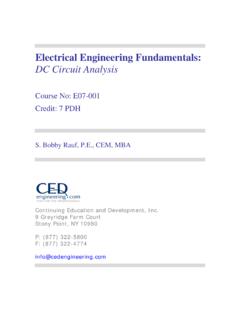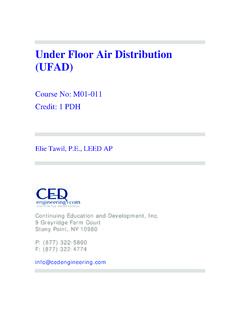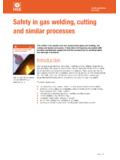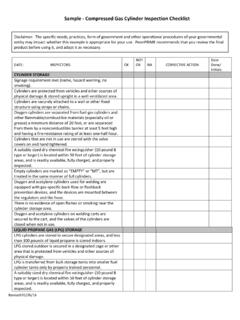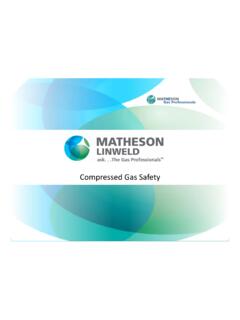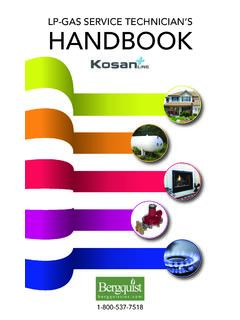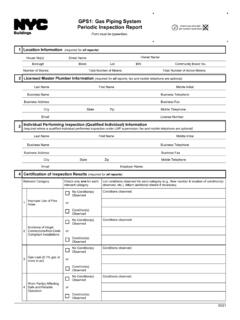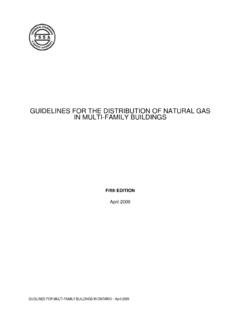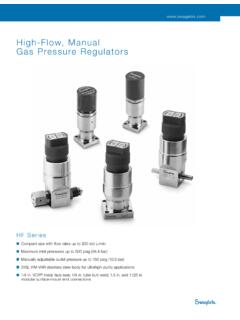Transcription of Fundamentals of Gas Cutting and Welding - CED Engineering
1 Fundamentals of Gas Cutting and Welding Course No: D06-002. Credit: 6 PDH. A. Bhatia Continuing Education and Development, Inc. 22 Stonewall Court Woodcliff Lake, NJ 07677. P: (877) 322-5800. Fundamentals . OF. GAS Welding & Cutting . GAS Welding AND Cutting . Oxy-fuel Welding , commonly referred to as oxy Welding or gas Welding is a process of joining metals by application of heat created by gas flame. The fuel gas commonly acetylene, when mixed with proper proportion of oxygen in a mixing chamber of Welding torch, produces a very hot flame of about 5700-5800 F. With this flame it is possible to bring any of the so-called commercial metals, namely: cast iron, steel, copper, and aluminum, to a molten state and cause a fusion of two pieces of like metals in such a manner that the point of fusion will very closely approach the strength of the metal fused. If more metal of like nature is added, the union is made even stronger than the original.
2 This method is called oxy-acetylene Welding . Cutting with the oxy-fuel process is just the opposite from of Welding . Oxy-fuel Cutting uses acetylene and oxygen to preheat metal to red hot and then uses pure oxygen to burn away the preheated metal. Because this is achieved by oxidation, it is only effective on metals that are easily oxidized at this temperature. Such metals are mild steel and low allow steels. Oxy-fuel Cutting can be used to cut thicknesses from 2/8 to up to 12 . Traditionally oxy-fuel processes are used for brazing, fusion Welding , flame hardening, metalizing, soldering, stress relieving, Cutting and bending. The primary uses today are Welding , brazing and Cutting . This course describes the basic concepts of oxy-fuel Welding and Cutting including what equipment and safety precautions are needed. Chemistry of Oxy Acetylene Process The most common fuel used in Welding is acetylene. It has a two stage reaction; the first stage primary reaction involves the acetylene disassociating in the presence of oxygen to produce heat, carbon monoxide, and hydrogen gas.
3 2C2H2 + 2O2 = 4CO + 2H2 + Heat ---------- (1). A secondary reaction follows where the carbon monoxide and hydrogen combine with more oxygen to produce carbon dioxide and water vapor. 4CO + 2H2 + 3O2 = 4CO2 + 2H2O + Heat--------- (2). When you combine equations (1) and (2) you will notice that about 5 parts of oxygen is necessary to consume 2 parts of acetylene 2C2H2 + 5O2 = 4CO2 + 2H2O + Heat ----------- (3). Or we can say about parts of oxygen is necessary to achieve complete combustion of acetylene. In operation, one part of oxygen is supplied through the torch and the remaining parts is obtained from the surrounding air atmosphere (secondary reaction). When the secondary reaction does not burn all of the reactants from the primary reaction, the Welding processes produces large amounts of carbon monoxide, and it often does. Because of the need for supplemental oxygen from the atmosphere, the acetylene oxygen flame cannot be used inside of pipes or structures subjected to oxygen depletion from gas Welding .
4 By varying the relative amounts of acetylene and oxygen, a welder can produce different flame atmospheres and temperatures as he requires. Oxy Fuel Welding Gases Commercial fuel gases have one common property: they all require oxygen to support combustion. To be suitable for Welding operations, a fuel gas, when burned with oxygen, must have the following: a. High flame temperature b. High rate of flame propagation c. Adequate heat content d. Minimum chemical reaction of the flame with base and filler metals Among the commercially available fuel gases such as propane, liquefied petroleum gas (LPG), natural gas, propylene, hydrogen and MAPP gas, Acetylene most closely meets all the above requirements. Acetylene is a hydrocarbon, just as are propane, methane, and virtually all the components which make up gasoline and fuel oils. However, it differs from those hydrocarbons in a way that its molecule is made up of two carbon atoms and two hydrogen atoms, the carbon atoms are joined by what chemists call a triple bond.
5 When acetylene reaches its kindling* temperature; the bond breaks and releases energy. In other hydrocarbons, the breaking of the bonds between the carbon atoms absorbs energy. The triple bond is the reason that when acetylene and oxygen are mixed and ignited, the flame can reach the temperature of 5700 F to 6300 F, highest among commonly used gaseous fuels. The other property of acetylene which you must remember is that acetylene/air mixtures can be ignited when they contain anywhere from percent acetylene to 80 percent acetylene. Mixtures of methane (the principal component of natural gas) and air are flammable when they contain as little as 5% methane and not more than 15% methane. *Kindling Temperature Kindling temperature is the lowest temperature at which a substance bursts into flame. The other two gases suitable for Welding and Cutting are: a) MAPP. b) Hydrogen MAPP gas is a registered product of the Dow Chemical Company.
6 It is liquefied petroleum gas mixed with methylacetylene-propadiene (acetylene + propane). It has the storage and shipping characteristics of LPG and has a heat value a little less than acetylene. Because it can be shipped in small containers for sale at retail stores, it is used by hobbyist. MAPP gas can be used at much higher pressures than acetylene, sometimes up to 40 or 50 psi in high-volume oxy-fuel Cutting torches which can cut up to 12 inch thick steel. A MAPP gas leak is easy to identify because of its particularly terrible odor. Hydrogen produces low-temperature flame and is best for aluminum. Hydrogen flame is non-luminous, commonly used for underwater Welding (can be used at higher pressure than acetylene). Gasses suitable for Cutting but NOT Welding : a) Propane b) Methane c) LPG. Hydrocarbon gases, such as propane, butane, city gas, and natural gas, are NOT. suitable for Welding ferrous materials due to their oxidizing characteristics.
7 Although propane has a very high number of BTUs per cubic feet in its outer cone, it does not burn as hot as acetylene in its inner cone and therefore not very useful for Welding operations. However with a right torch (injector style), propane can make a faster and cleaner Cutting and is much more useful for heating and bending applications than acetylene. In some instances, many nonferrous and ferrous metals can be braze welded with care taken in the adjustment of flare and the use of flux. Characteristics of Acetylene: 1) Hydrocarbon - It burns in two stages with primary combustion zone (cone flame). and secondary combustion zone (envelope flame);. 2) Acetylene is a colorless gas with a very distinctive, nauseating odor that is highly combustible when mixed with oxygen. 3) Acetylene gas is formed by the mixture calcium carbide and water and is composed of carbon and hydrogen having the chemical formula C2H2.
8 4) Neutral flame temperature of 5420 F at the end of the inner cone. This can be increased to a maximum of about 5800 F by increasing the oxygen quantity through the torch (oxidizing flame);. 5) Combustible intensity is 12700 BTU/sec. /sq. ft. of cone area in a one to one mixture of acetylene and oxygen through the torch;. 6) Net heat value of 1433 BTU per cubic foot;. Advantages of Oxyacetylene Process 1) Does not require electricity;. 2) The equipment is portable, easy to transport;. 3) Welder has considerable control over the rate of heat input, the temperature of the weld zone, and the oxidizing or reducing potential of the Welding atmosphere;. 4) Oxyacetylene process is ideally suited to the Welding of thin sheet, tubes, and small diameter pipe. It is also used for repair work, maintenance and in body shops;. 5) Dissimilar metals can easily be joined;. 6) Can also be used for preheating, Cutting metal, case hardening, soldering and annealing.
9 Limitations of Acetylene 1) Acetylene becomes extremely dangerous if used above 15 pounds pressure. Pure acetylene is self-explosive if stored in the free state under a pressure of pounds per square inch (psi);. 2) The process is typically slower than the electrical arc- Welding processes;. We will learn more about the oxyacetylene process and equipment in this course. The course is divided into 4 sections: Section -1 Oxy-Acetylene Apparatus Section -2 Oxy-Acetylene Welding Section -3 Oxy-Acetylene Cutting Section -4 Oxy-Acetylene Safety & Precautions including case study Annexure -1 Terminology SECTION - 1 OXY-ACETYLENE APPARATUS. Before discussing how the system works, it is important to know the name of the components that makes the oxy-fuel apparatus. Oxy-fuel apparatus consists of two cylinders (one oxygen and one acetylene) equipped with two regulators, pressure gauges, two lengths of hose, and a blow torch.
10 The regulators are attached to cylinders and are used to reduce and maintain a uniform pressure of gases at the torch. The gases at reduced pressure are conveyed to the torch by the hoses. The regulators include high pressure and low pressure gauges to indicate the contents of the cylinder and the working-pressure on each hose. When the gases reach the torch they are there mixed and combustion takes place at the Welding tip fitted to the torch. Oxy-acetylene Welding outfit The basic equipments used to carry out gas Welding are: 1. Oxygen gas cylinder (green). 2. Acetylene gas cylinder (maroon/red). 3. Oxygen pressure regulator 4. Acetylene pressure regulator 5. Oxygen gas hose(Blue). 6. Acetylene gas hose(Red). 7. Welding torch or blow pipe with a set of nozzles and gas lighter 8. Trolleys for the transportation of oxygen and acetylene cylinders 9. Set of keys and spanners 10. Filler rods and fluxes 11.
